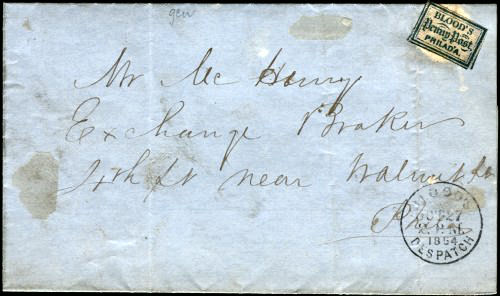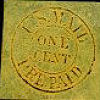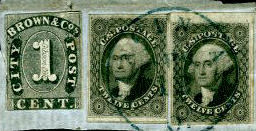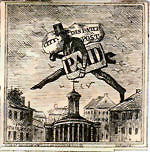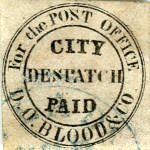![]()
Postal History Introduction
Stampless
Covers
1846
to 1900 Issues
1901-1950
Issues
1951-2003
Issues
Cancels
&
Miscellaneous
Postal
Stationery
Post
Cards
Air
Mail
First
Day &
Event Covers
Parcel Post/Special Delivery
Registered & Official Mail
Commercial & Advertising
Revenue & Postage Due
Wildlife & Game Issues
Complete List of RI Issues
|
Independent Mail & Local Carrier - Covers
and Stamps
|
|||
|
|||
|
Local Stamps are those stamps issued by private City Posts, (such as the example above), independent mail routes and private, express companies. City Posts generally charged 1 cent to deliver a letter to the post office and 2 cents to deliver it from one location in the city to another. Very few of the local city posts used separate cancellation devices. The cover above has a Bloods one cent, blue 1854 issued stamp, which has been acid tied (canceled) to the cover. The 1 cent stamp paid for delivery to the local post office, where the recipient would have picked it up. The stamp is listed in the Scott Catalog as 15L15 and is valued, "acid tied to cover" at $50.00. If the Bloods hand-stamp at the lower right corner had been used to tie the stamp; the value would have been increased fourfold. When I received this cover, I opened the letter to see if there was any additional writing on the inside/reverse of the letter text. Four additional items were hidden inside the letter; a carrier stamp, 2 local post stamps and a local post with two #17 imperforate 12c Washington issues of 1851. In New Orleans, we call this Lagniappe, (pronounced LAN-YAP) or free gift. I have included those issues in this article with background information. |
|||
|
Carrier stamps such as the stamp to the left, (New York City Dispatch issue of 1849-50 - Yellow - one cent Scott #6LB10) were issued by city postmasters under the authority of the Postmaster General and are semi-official stamps. They were used to defray the costs by "Postal Carriers" who were contract employees of the post office. Some of these carriers were paid a salary, however many of them were paid by the fees collected from the "carrier stamps." On June 30, 1863 all carriers became government employees paid by salary and the carrier fees were discontinued. |
||
|
The local stamp on piece to the left is a Brown & Co from Cincinnati and was used from 1852 to 1855. It is a 1 cent Gray/Black; Scott #29L1. The Two Scott Nr. 17s (12 cent Black Washington of 1851) are tied with a blue Cincinnati CDS. The 1 Cent Brown and Co City Post was the cost of private delivery to the post office. The two 12 cent Washington's covered the Transatlantic or British Treaty rate of 24 cents. The Brown & Co lists for $150 and the Washington Imperf stamps list at $325 each in VF condition. The 12 cent stamp to the right is actually a top corner sheet stamp with all four margins and should be considered as in extra fine condition. All in all, these were quite a surprise and I might add a very pleasant one. |
||
|
In addition to the above issues, there were two additional Blood's Locals found in the letter, however after examination with my local stamp dealer; we determined that both of these were forgeries. They are shown below along with the points that mark them out as forgeries. There were a great many forgeries of both the locals and carriers made. Generally these are cruder than the originals and can be easily told apart.
The stamp to the right is a forgery of Scott #15L2 and is listed as "Forgery A - Type II." The main points that distinguished this stamp as a forgery were the lack of legible writing on the building to the extreme left and the lack of the initials "LEBG" on the building below the mans rear knee. The stamp to the left is a forgery of Scott #15L7 and is listed as "Forgery A". This can be determined by several factors; there is no period after office in the right upper circle, (The original has a period). Despatch in the center does not quite touch the inner circle, (in the original it is tight against the inner circle). |
|||
![]()
RI Historical
Society
The Post Offices
Home Page
RI Tercentenary Issue History
RI Philatelic Society
Recently Added Pages
Philatelic Primer
Rhode Island Around the World
Rhode Island
Town Postmarks
Other Websites of Interest
